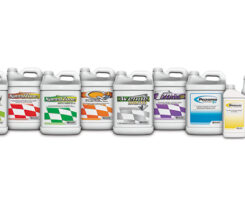Surveying the superintendents on EOPs

The Abaco Club in the Bahamas tries to order an entire year’s worth of products through early order programs. Pictured here are the club’s fifth and sixth greens. (Photo: The Abaco Club)
Early order programs (EOPs) can be a source of stress for superintendents in a typical year — reflecting on past turf problems and fielding calls from salespeople while still in the chaos of the golf season. Then throw in a global pandemic as maintenance was about to kick off for the 2020 season in many parts of the country, and that has the potential to shake up even the best-laid plans.
In May and June, Golfdom surveyed readers about their opinions on EOPs and their outlook on how they plan on ordering for the 2021 season. In September, we interviewed a few superintendents to get their takes on EOPs. Here’s what we learned.
Worth the work
“I’m just a huge fan of EOPs, because I feel if you have a history at a facility and your agronomic plan, you know what you’re going to do, unless something crazy gets thrown your way,” says Matt
DiMase, director of agronomy and landscape at The Abaco Club on Winding Bay, Great Abaco, Bahamas.
DiMase says that he purchases 95 percent of his fertilizer and pesticide chemicals through an EOP. Considering that he’s on an island and doesn’t really know what to expect weather wise, he says he tries to buy his entire agronomic plan for the year during EOP season.
“I feel like you can save dollars and if you can commit to the product you’re going to use — why not do it?” he says, noting that with manufacturer rebates that come at year-end, ultimately, superintendents’ cost per acre for any EOP comes out cheaper than if they didn’t purchase in an EOP.
As for the younger superintendents or those just working on their first EOP, DiMase says your first several EOPs and the first order you do are the hardest.
“It’s a challenge, and most GMs will challenge superintendents, because when we turn in that EOP order that’s in the six-figure range, that’s a big number for accounting,” DiMase says. “If you show (your club) the value, where you’re getting a percentage back and that you’re actually saving money, it will show them that you’re spending dollars in the best interest possible. My advice is work through it and understand it.”
With paspalum turf and a subtropical environment in the Bahamas, DiMase’s typical EOP purchases include Primo Maxx growth regulator and fungicides. “Given where I am, I can’t just have a vendor show up on the weekend with a truck full of Segway if I have Pythium pop up,” he explains.
Despite the uncertainty blanketing the industry since the beginning of the coronavirus, DiMase doesn’t intend to adjust his early order program plan for 2020.
“There have been some discussions about my 2021 budget being slightly modified, but I have several line items that are untouchable, and one of those is my fertilizer and chemical budget because of what we just endured with (Hurricane) Dorian,” he explains. “But, COVID has not really affected it.”
A cautious approach
Tom Brodeur, golf course superintendent at TPC Boston in Norton, Mass., wasn’t an early convert to EOP programs.
He says that since chemical companies have adapted and provided discount levels to achieve and become more user friendly, he’s come around. “At some point, you’re probably throwing money away if you don’t use them,” he says. “The hard part is trying to predict what the next year will be, so I like to leave some room to adapt — especially this year. I’ll have to be careful so as not to overextend ourselves.”
Tim Davis, golf course superintendent at Legacy Ridge GC in Westminster, Colo., agrees with the cautious approach. He typically plans to purchase 30 to 40 percent of his agronomic program through early order programs — PGRs and fungicides in particular.
“I wouldn’t want to operate strictly on EOPs, but it’s very useful for the products that make up the backbone of your agronomy program,” he says. “If you know you’re going to buy something for next year, use an EOP —that’s usually the best price you’ll get.”
Hit reset
Going into the 2020 season, Paul Culclasure, CGCS of Kilmarlic GC, Powells Point, N.C., was comfortable. “For the most part, I knew what I was going to order for basic preventive programs,” he says. “I knew what I was going to need for the upcoming year, and it worked out well.”
Then, the pandemic hit, and Culclasure says that the bridge into his small island town shut down.
“I was a little panicky,” he admits. “I had all this chemical sitting here in the shop, and I didn’t know if I was going to be able to pay for it.”
Luckily, the club opened after two months and has been having one of its best years ever.
On an average year, he estimates that he saves about $10,000 to $15,000 — enough to basically pay for his preemergence products.
For the 2020 EOP, Culclasure has decided to flip from his typical 60 percent of his product on EOPs and 40 percent buy-as-you-go, to 40 percent EOPs and 60 percent buy-as-you-go.
“With bentgrass in the Southeast and the summertime, it’s stressful, it’s tough. For me, EOP season is like a holiday. They’re a reset button. It’s like ‘Fall’s here — now I can start planning my program for next year.’”
Editor’s Note: As of press time, Paul Culclasure has left Kilmarlic GC and is now a sales arborist at SavATree.













